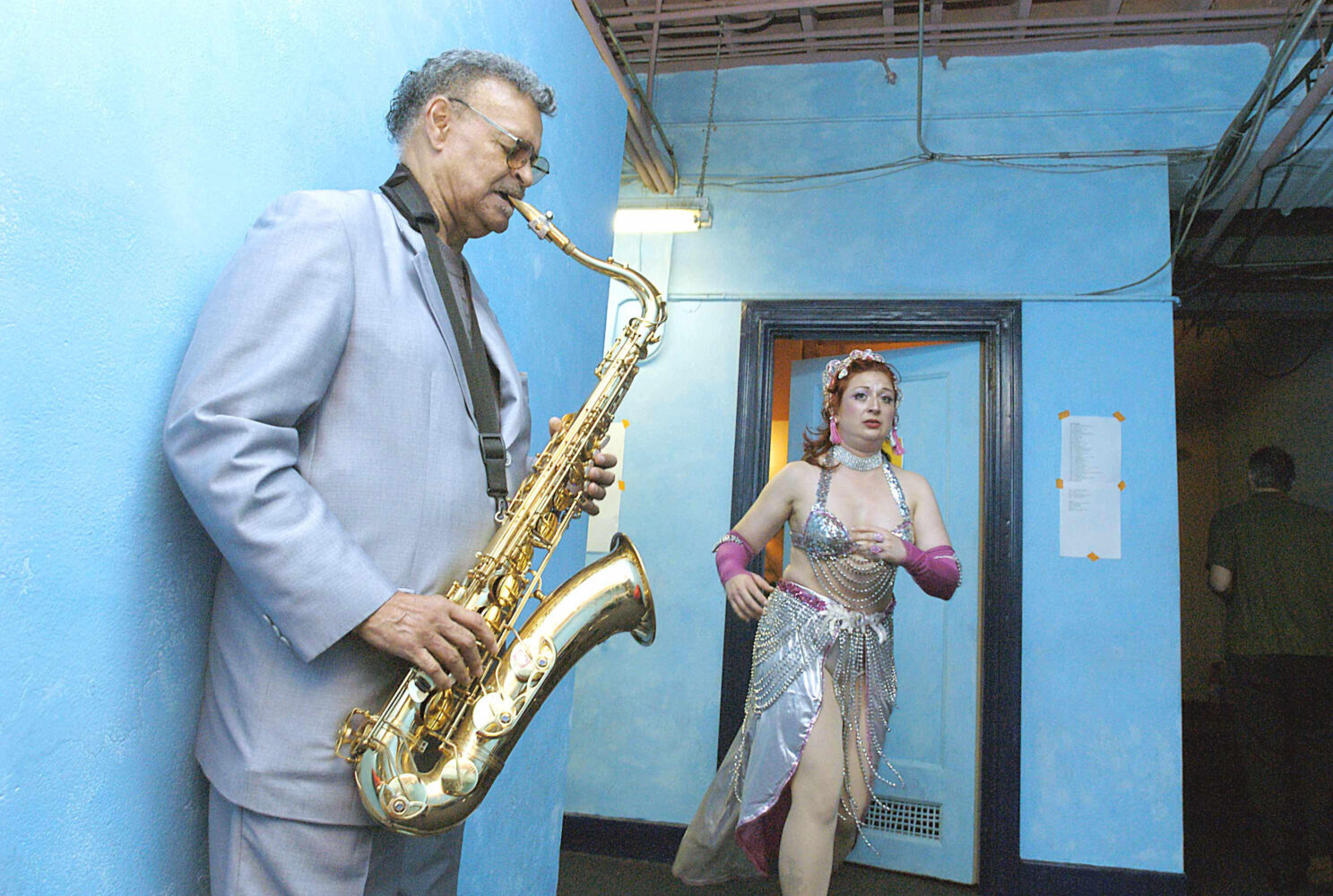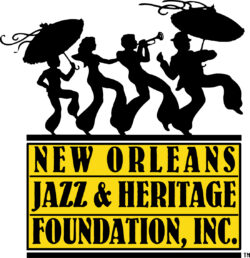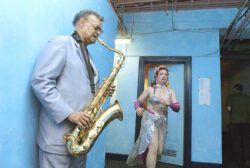Plas Johnson
A prolific session musician with a sound all his own
Published: November 30, 2021
Last Updated: June 1, 2023

ZUMA Press, Inc. / Alamy Stock Photo
Johnson warms up for his gig with the SophistiCats band at Tease-O-Rama, a burlesque festival, as MC Kitten on the Keys scurries by, October 11, 2003.
Johnson, who turned ninety on July 21, 2021, re-recorded “The Pink Panther Theme” for the 2004 Mancini tribute album, Ultimate Mancini, and the 2006 Pink Panther remake starring Steve Martin. It’s one of the dozens of film and television soundtracks he recorded. A Donaldsonville native who left Louisiana in 1951, Johnson was even more prolific in the music business. From the mid-1950s on, his sax playing enhanced hundreds of stars’ recordings.
“If producers couldn’t get Plas, they got someone who sounded like him,” Harold Battiste, Johnson’s fellow Louisianan in the Los Angeles recording studio and television scene, recalled in his autobiography. “His recording credits are endless.”
Even an abbreviated list of Johnson’s studio work is breathtaking: The Platters (“The Great Pretender”), Bobby Day (piccolo in “Rockin’ Robin”), Larry Williams (“Bony Moronie”), Sheb Wooley (“The Purple People Eater”), Ricky Nelson, Little Richard, Gene Vincent, Fats Domino, Frank Sinatra, Peggy Lee, Nat King Cole, Ella Fitzgerald, Nancy Wilson, Sam Cooke, the Beach Boys (Pet Sounds), Nancy Sinatra, Dr. John (Gris-Gris), Steely Dan, Marvin Gaye, Rod Stewart, Linda Ronstadt, Aaron Neville, and many more.
“I’d just go in and do what they asked for,” Johnson told the Long Beach Press-Telegram in 2005. “It was easy for me and they liked what I played. You just have to know when to start and when to stop.”
In interviews through the years, Johnson revisited the making of his most famous recording. On a cold morning in Los Angeles, conductor-composer Mancini and a large ensemble gathered at 8 o’clock. Their first run-through for “The Pink Panther Theme” delighted even the normally stuck-up string players. “It was special from the first minute it was played,” Johnson said in 2007 following a visit to Donaldsonville for the dedication of the city’s Bicentennial Jazz Plaza. “We played the arrangement once and, after that, the band applauded. That was a compliment to Henry and to me also, I guess, because I soloed on the introduction, in the middle, and on the end.”
“If producers couldn’t get Plas, they got someone who sounded like him.”
Johnson’s association with Mancini began when the composer was an assistant arranger at Universal Studios. Mancini’s breakthrough happened with the Peter Gunn TV series. Although Johnson didn’t play for the Peter Gunn soundtrack, he re-recorded the theme for Mancini’s million-selling 1959 album The Music from Peter Gunn. Mancini became a star, but his soloists remained unknown. Decades later, when people in Johnson’s audiences approached him and said that he played “The Pink Panther Theme” just like the guy in the movie, the saxophonist replied: “Well, I am the guy who played it in the movie.”
Johnson and other studio musicians who crafted the sound of popular music in the 1960s and ’70s received belated recognition in the 2012 book The Wrecking Crew and corresponding documentary. The film’s interviewees include Johnson and Earl Palmer, the prolific session drummer originally from New Orleans. The Louisiana expatriates played many sessions together, including their 1959 rock and roll rendition of Glenn Miller’s “In the Mood,” a number-four pop hit credited to the Ernie Fields Orchestra.
Johnson’s mostly self-taught artistry ensured his presence in recording studios for more than fifty years. He also released records under his own name, including a handful of Capitol Records singles, the Capitol albums This Must Be the Plas! and Mood for the Blues, and his mid-1970s albums for Concord Jazz.
Born in 1931, John Plas Johnson Jr. grew up with professional musician parents. “When we lived in Donaldsonville, there was a family band that played up and down the bayou,” he said. Music remained an important source of income after the family moved to Thibodaux. “If my father had a day job somewhere, he was lucky, because nobody was working in the ’30s.”The Johnsons moved to New Orleans when he was about twelve. It was there that his alto saxophonist father gave him a soprano sax. Graduating to tenor sax at fifteen, he formed the popular Johnson Brothers Combo with his older brother, Ray, a pianist. “All the parishes in the New Orleans area had dances for the young people once a month,” he said. “We played Louis Jordan music, Dinah Washington music, Charles Brown blues. We were fascinated with bebop, so we always had two or three Dizzy Gillespie, Charlie Parker tunes. We never had requests for them, but we liked to play them.”
Still teenagers, the Johnson brothers moved to nightclubs. In 1951, Charles Brown (with the number-one hits “Trouble Blues” and “Black Night”) heard the nineteen-year-old Plas Johnson play at the Dew Drop Café. “Charles offered me a job,” Johnson said. “This was Sunday night. Monday I was gone.” But the gig with Brown ended after Johnson received a draft notice six months later. Serving part of his Army hitch in the band at central California’s Camp Roberts, he made weekend visits to the Monterey area. Post-Army gigs there set the pattern for the ballads and blues that became his specialty.
In 1954, Plas and Ray Johnson and their younger sister Gwen, a singer, moved to Los Angeles. The brothers played at the city’s jam sessions, hoping band leaders would hire them. Johnson’s blues-touched sax soon brought him recording dates. “It was really being in the right place, at the right time,” he says in The Wrecking Crew documentary. His early studio work included The Platters’ “The Great Pretender,” a number-one pop hit in February 1956. “When rock and roll came in, in 1956, many R&B artists started recording for various labels, like Modern and Aladdin and Specialty,” he said in 1993. “I did a lot of work with those labels and, as the music became more and more popular, I got more busy.”
The stylistic range of Johnson’s studio work expanded after Dave Kavanaugh at Capitol Records noticed him during a Johnny Otis session. “He invited me back to play with some of the great artists of my time,” Johnson said. “Peggy Lee, Nat Cole, Frank Sinatra. I was in awe.”
Johnson stayed extremely busy in the studio until sixteen-track recording became dominant in the late 1960s. “In the old days, when I’d get called for a Nancy Wilson date, I would see Nancy,” he said in 1991. “The last few dates, though, there was no Nancy. Her performance would not go on until all the music was on the track. That became quite boring.”
Johnson still played sessions, even during his fifteen-year, five-day-a-week run with The Merv Griffin Show. “It was the best of all worlds, a jazz band on a commercial TV show,” he said. In the ’80s and later, Johnson also continued recording as a leader, albeit releasing his albums independently. Into the past two decades, he answered calls for more featured studio work and performed engagements at clubs, hotels, and festivals, including the New Orleans Jazz and Heritage Festival and Ponderosa Stomp in New Orleans.
“I’ve been playing around L.A. all my life,” he said in 2007. “I see some fans who knew me when I played in Black clubs on the Westside in the ’50s. It’s kind of special, because I have my own set of fans.”
And as time goes by, Johnson’s performances for hundreds of classic recordings keep delighting audiences throughout the world—whether they know his name or not.
John Wirt is the author of the New Orleans music biography Huey “Piano” Smith and the Rocking Pneumonia Blues. He’s also written thousands of music and film stories and reviews for newspapers and magazines.
Sound Advice is funded in part by a grant from the New Orleans Jazz & Heritage Foundation.

